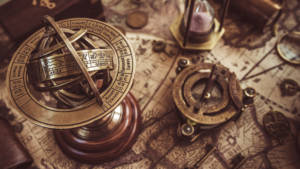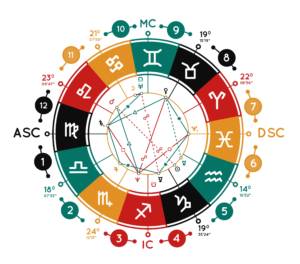Dignities: Planets’ Strengths and Weaknesses Within the Signs
A planet’s effects can be positive, powerful, negative, or hindered. These positions, or planetary dignities, reveal a lot going on beneath the surface.
If you’re like many young Canadian adults, you probably have a passing interest in astrology. You at least know your Sun sign, but you may have also looked up your chart and know what your planets’ positions mean. Yet there’s always more to learn, right? Based on the signs they inhabit, a planet’s effects can be positive, powerful, negative, or hindered. These positions, also known as planetary dignities, reveal a lot more going on beneath the surface.
What Are Dignities?
In astrology, dignities are simply shorthand for each planet’s strengths and weaknesses. Writing at The Tarot Lady, astrologer Theresa Reed discusses how dignities work. All the zodiac signs and planets have their own unique energies. These energies can blend harmoniously or clash horribly. Sometimes they enhance each other to produce powerful results. At other times, a zodiac sign’s energies diminish a planet’s nature like water being dumped onto a fire.
Dignities are these specific energy combinations. Meanwhile, a planet is said to be peregrine when it doesn’t possess any dignities at all. A peregrine state doesn’t inherently have positive or negative effects since the planet’s and sign’s influences don’t impact each other in any extreme ways.
Domicile: A Planet in Its Home Turf
Each zodiac sign is ruled by at least one planet. You can think of that sign as the planet’s “home base,” but astrologers refer to the planet as being in domicile or ruler-ship. Thanks to their compatible natures, these energies blend successfully and result in positive, natural impacts. For instance, someone with a natal Mercury in Virgo is an adept communicator with a quick intellect and ability to work with large amounts of information. Astrostyle offers a helpful list of ruling planets and their corresponding signs.
Detriment: Walking on Shaky Ground
When a planet’s in the zodiac sign opposite its domicile, astrologers say that it is in detriment. This position creates an awkward clash between the planet’s and sign’s influences, rendering the planet weaker and less effective. Some astrologers consider Saturn to be in detriment when it’s in Leo. Individuals with this placement may struggle with self-expression, confidence, and spontaneity: all Leonine traits impacted by Saturn’s restraining nature.
Exaltation: Strength in Numbers
If a planet’s influence feels the most natural in a domicile sign, then it enjoys a boost of power and strength when it’s in exaltation. Astrologers believe that this is a planet’s best possible placement because its exaltation sign multiplies and enhances its native energies. Uranus in Scorpio is one great example of this. As a planet governing innovation, technology, eccentricity, and rebellion, its presence in the ultimate sign of mystery, sexuality, and intensity magnifies its influence. Uranus was exalted in Scorpio between late 1975 and late 1981, and this confluence suggests people with unorthodox approaches to sexuality and resistance against traditional norms.
Fall: Incompatibility at Its Worst
A planet’s exaltation and fall signs can be located at opposite ends of the zodiac. When a planet’s in fall, its native energies don’t function well or at all because they’re completely incongruent with those of the sign. For instance, a Venus in Virgo within someone’s natal chart may result in a person who demonstrates love through service yet struggles with being overly critical of romantic partners. That’s because the planet of love and attraction finds its influence constricted by Virgo’s practical, precise, and analytical nature.
The Relationships Between Planets and Signs
A lot of people may know their sun signs and a few planets in their charts. However, many complex ideas are involved with a chart’s interpretation. Planetary dignity is one such concept, describing the unique relationships between each planet and the sign in which it’s present. When you’re reading your chart, look at these planet-sign positions to better understand their effects.
Where Do Your Planets Live? Astrology’s Horoscope Houses
Astrology is more than just zodiac signs. Horoscope house systems can map life concerns to specific celestial regions.
When many people learn about astrology, they focus mostly on the signs in which planets are positioned. Yet for professional astrologers and many enthusiasts, there’s much more to a person’s birth chart than just zodiac signs. With collections of unique energies and traits, horoscope houses can reveal much more information about an individual’s personality and life path.
A Quick History of Horoscope Houses
The Babylonians had developed a form of horoscopic astrology for drawing up natal charts by the end of the Iron Age. Astrodienst explains that the ancient Greeks were among the first to use astrological house systems. Kepler College adds that more than 20 house systems exist, each using a different approach to divide the natal chart. Today, the most popular ones are the Placidus, Koch, Equal House and Whole Sign systems. Each house represents a specific area of a person’s life.
Drawing the Houses on a Birth Chart
Birth charts are typically drawn as circles, each with two concentric rings on the perimeter. The 12 zodiac signs are placed on the outer ring, but horoscope houses are mapped on the inner ring. Astrologers use the ascendant, or rising sign, to determine the first house’s placement.
Finding an ascendant requires the person’s exact date, time and place of birth. Remember that the birth chart contains a snapshot of planet and point positions in the sky when an individual is born. The ascendant on the left side represents the eastern horizon, and the descendant on the right side signifies the western horizon. While the horizons are fixed, the zodiac sign sitting at that point shifts as the earth rotates.
Horoscope Houses and Their Meanings
Astrostyle offers a quick guide to the 12 horoscope houses. If you draw a straight line between the ascendant and descendant points on a birth chart, this splits the chart horizontally into two halves. The six horoscope houses below this axis represent personal concerns:
- First house: self, beginnings, identity, and appearances
- Second house: money, material concerns, and self-esteem
- Third house: the mind, communication, siblings, and education
- Fourth house: privacy, security, self-care, and nurturing
- Fifth house: romance, love, creativity, self-expression
- Sixth house: health, fitness, work habits, and service
Meanwhile, the six above the axis are referred to as interpersonal houses. This makes sense since the birth chart area below the axis denotes the night and the area above symbolizes the day. What’s personal remains below the surface, while social aspects are more readily seen by others in the light. Astrostyle briefly describes the six interpersonal houses:
- Seventh house: relationships, partnerships, contracts, and marriage
- Eighth house: transformation, sexuality, inheritances, and shared finances
- Ninth house: travel, higher education, wisdom, and philosophy
- Tenth house: career, long-term goals, status, and reputation
- Eleventh house: social awareness, friends, technology, and the future
- Twelfth house: endings, closure, death, and spirituality
The Blending of Planet and House Energies
Just as planet and zodiac sign energies combine, the same is true of planet and house energies. Each house has a ruling sign, so the sign’s and house’s traits tend to be similar. To understand how this works, consider a planet-house placement with compatible energies: a natal Sun in the fifth house. The Sun is Leo’s ruling planet, and Leo rules the fifth house. Self-expression, creativity, and romance would probably feel natural to a person with this placement.
Planet-house placements can also bring together less compatible influences. One example is restriction-minded Saturn appearing in moon-ruled Cancer’s fourth house. Saturn’s limiting energies could impact familial love and nurturing. A person with this placement may experience a childhood that seems cold and unloving.
Celestial Movements and Divination
Astrology is more than zodiac signs. Horoscope house systems map life concerns to specific celestial regions. Using planetary positions in these houses, astrologers try to make sense of how these energies impact our personalities and lives.
Understanding Yourself: What Your Rising Sign Can Tell You
Astrologers believe that each part of our birth charts tells us about ourselves and our lives. Taking a closer look at your sign can reveal some surprises.
Peruse astrology websites or hang around some enthusiasts and you’re likely to encounter a lot of discussions about rising signs. Perhaps you’ve pulled up your birth chart to find out your rising sign or heard the term “chart ruler” tossed around. Yet what does this all mean? Answering that question involves some science, geography, and a peek into the human psyche.
What Is Your Rising Sign?
Your birth chart shows quite a bit of information. Mastering the Zodiac briefly explains what each detail means, focusing on four primary elements: the Sun, the Moon, the rising sign, and the chart ruler. Mastering the Zodiac and other astrology sources sometimes refer to the rising sign as the “ascendant,” but it’s more than just a fancier word for the same concept. As Astrostyle reveals, it’s the zodiac sign that’s ascending above the eastern horizon at the time each person is born.
As you may already know, some planets and points change position more slowly than others. Consider our Moon, which makes its trip around the Earth in only 27 days. With such a short orbital period, our speedy satellite stays in each zodiac sign for only 2.5 days. The ascendant changes signs even faster than that. Depending on a location’s latitude, each sign takes anywhere between 30 minutes and three hours to cross the horizon. The earth’s axial tilt of 23.5 degrees also causes these differences, with the ascendant jumping 180 degrees or disappearing completely in extreme northern and southern locations.
Because of how quickly the rising sign changes, finding it requires knowing a precise time and place of birth. Even twins born a minute apart can have different ascendants if a sign finishes crossing the horizon before the younger one is born. If you’re not sure about your ascendant, check your birth certificate to get an accurate time of birth. You can plug this data into any free birth chart generator to see your results.
What Your Ascendant Means
You may have heard that our ascendants represent the masks that we wear, the faces that we choose to show to the world. This is one basic interpretation, but Astrostyle adds that it’s the sign of first impressions. The way you dress, your interpersonal style, your demeanor, and even how you style your hair are connected to your rising sign. It adds another layer to how you can be perceived by others. Astrologers often say that it’s one possible reason you could be mistaken for a zodiac signifier other than the one under which you were born.
Mastering the Zodiac suggests additional meanings for you. While it may speak to how you present yourself to others, it can also reveal the qualities you’re developing as you age. If we look at both points of view, the ascendant represents both the personality you show to others as well as the personality shaped by your life experiences.
Your Rising Sign and Chart Ruler
The rising sign has another important function: determining the chart ruler. In astrology-speak, the chart ruler is simply the ruling planet of your rising sign. For instance, someone with an Aries ascendant has Mars as a chart ruler. This planet exerts its influence over the entire natal chart in areas such as personality, goals, desires, and strategies for learning, relating to others, and solving problems. In our Aries ascendant example, Mars will significantly impact whatever signs and houses it’s in. This individual may love competition, testing oneself, and pushing the limits.
Astrologers believe that each part of our birth charts tells us about ourselves and our lives. The rising sign represents the impression we make on others, but it also speaks to central life themes. Taking a deeper look at your ascendant can reveal some surprising details.





